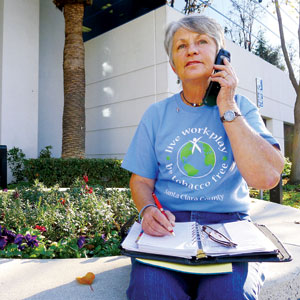A drink and a drag off a cigarette were once a classic fixture of American nightlife. But in the mid-‘90s, new laws made smoking illegal in California bars and other public places, and to light up a cigarette meant placing a coaster on a pint and stepping out the door.
Increasingly, cities around the Bay Area now are considering taking the law much further than that. Multiple municipalities in the South Bay are putting forth proposals to make smoking in public and, in some cases, inside one’s home, illegal.
With the aid of a $6.9 million federal grant aimed at reducing secondhand smoke in Santa Clara County, the cities of Gilroy, Sunnyvale, Morgan Hill, Palo Alto and San Jose have all taken steps toward a tobacco-free future, with some community activists pleading for laws to make butts illegal altogether.
Linda Roma is one such person. A smoker for 36 years, the Morgan Hill resident quit when she noticed the exhaled plumes harming the health of her husband, who had developed a brain tumor. Now, as Morgan Hill officials draft a strict ordinance against public smoking, Roma is ready to see cigarettes banished. Unlike some who are in favor of partial restrictions, Roma—who has attended three recent public meetings to voice support for an ordinance—wants something close to full prohibition.
“If we’re going to do this, we should just do it across the board,” Roma says, naming side-by-side living units, sidewalks, parks, playgrounds and areas of employment as places she thinks smoking should be illegal. “That makes it the easiest to understand and the easiest to enforce.”
In San Jose, anti-tobacco organization Breathe California is leading the attack on public smoking. CEO Margo Sidener says lawmakers should consider the overwhelming support for smoking bans revealed through surveys and questionnaires.
“People who oppose these bans forget that there’s the 90 percent of people who don’t want to breathe secondhand smoke,” Sidener says. “The fact is, cigarettes kill people and cause lung cancer and heart disease, and I think you have to have more compassion for the people whose health may be harmed than for the people who want to be able to do something that’s known to be dangerous for others.”
A survey randomly conducted by the city of Morgan Hill found that most people favor the idea of a ban. Of about 500 people questioned, 76 percent supported a ban on smoking in private doorways, 56 percent supported a ban on smoking at all public events, 66 percent supported a ban in all city-owned recreation areas and 53 percent supported a ban on smoking on all public sidewalks.
Breathe California asked the owners and managers of 173 San Jose restaurants if they would oppose an ordinance against smoking in outdoor dining areas; 158 said they would not object to such a law, according to Sidener.
She points out that smoking has never been a civil right. “It’s a privilege,” Sidener says, “and society allows us some privileges and not others.”
The battle has advanced dramatically since the 1980s, when merely establishing smoking and nonsmoking sections in public places, like restaurants and airplanes, proved difficult. Santa Clara County received federal money in 2010 through the American Recovery and Reinvestment Act, aimed at curbing smoking. Around the world, 2,106 states, commonwealths, territories, cities and counties now enforce laws against smoking in one or more outdoor areas, according to the Americans for Nonsmokers Rights website. In California, 164 cities and counties—including 23 in the Bay Area—now prohibit smoking in parks.
But Jeff Burrus, co-owner of the Morgan Hill Cigar Company, thinks people should have the privilege of lighting up. His shop is among the few county establishments where smoking is allowed, thanks to an exemption in the state commerce code that overrides any city ban. “I’m fighting it as a violation of the freedom of choice,” Burrus says. “This is a case of one group forcing their will and their want onto another group.”
Burrus’ business partner, Mike Davenport, lobbied for smoking restrictions in the past and recently helped push through an oncampus ban in the Gavilan Community College District, where he serves as a trustee. But when it comes to individual businesses, he and Burrus both believe they should be allowed to make their own choices about smoking on the premises.
{pagebreak}
“This is a matter of property owners’ rights,” says Davenport, adding that new bans are “an example of far, over-reaching authority.”
In Belmont, city law forbids smoking on sidewalks, in parks, at public events and in all residences except free-standing townhouses and single-family homes. The restrictions took effect in January 2009, several years after Ray Goodrich, a resident of a multi-unit complex, began writing letters to the city complaining that smoke from his neighbor’s apartment was drifting through the ventilation shafts into his own home.
Though the city has received 138 complaints about violations of the ordinance in the past three years, no citations have ever been issued, according to Belmont’s officer of code enforcement, Kirk Buckman. He says the bulk of the calls came soon after the ban.
“There was a lot of controversy at the time,” says Belmont’s former mayor, Coralin Feierbach, who spearheaded the effort to ban smoking about six years ago. “But things have changed. People just don’t want to be in a place where others are smoking.”
Now, the concept of eliminating secondhand smoke from multi-housing living units is spreading. Earlier this month, the Tri-County California Apartment Association announced that starting in January its member property managers will be strongly encouraged to forbid tenants from smoking and make it a violation of their lease to do so.
Up in Smoke
According to Robert Proctor, an author and professor of the History of Science at Stanford University, people who smoke aren’t the source of the problem. Proctor’s new book, Golden Holocaust: Origins of the Cigarette Catastrophe and the Case for Abolition, due out in January, describes the firm grip that the tobacco industry maintains on hundreds of millions of nicotine addicts.
Proctor admits that the fight against smoking will be a difficult one, especially for those battling the powerful tobacco industry, which took Proctor to court in a failed effort to block publication of his book. Though national anti-tobacco campaigns seem to be effective—per capita smoking is down by almost half nationwide since 1982—Americans still smoke 340 billion cigarettes per year. Proctor says that Californians consume 28 billion cigarettes annually, a rate that is just less than the worldwide average.
Proctor says that people who smoke are not so much exercising a right as they are being victimized by an industry. “Even smokers don’t like smoking,” he says, explaining that nicotine is not a recreational drug the way alcohol and marijuana are. “Only 3 percent of drinkers are alcoholics while nearly every smoker is an addict. Smoking is much more like heroin than drinking.”
Though some dispute the notion that secondhand smoke is dangerous, Proctor asserts that cigarette smoke can ride on a breeze in unbroken streams to bystanders as far as 100 feet away. This, he says, merits the increasingly common proposals by city governments to ban smoking in outdoor places.
While some call the new measures invasive and draconian, Proctor believes grassroots policies and local-level laws like these have the greatest power to harm the tobacco industry.
“Their lobbyists just don’t have the manpower to come out to all these cities and fight the laws,” Proctor says. “They hate these local ordinances more than the state laws, and they probably won’t even come in and fight because they’ll look like bullies. What the tobacco industry wants is to be invisible.”

 Review: Manresa’s Bar
Review: Manresa’s Bar  Best Bites: Breakfast in San Jose
Best Bites: Breakfast in San Jose 

